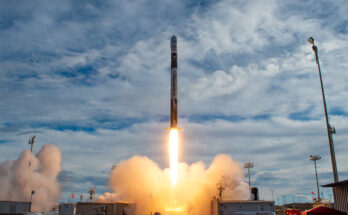by Bill Ostrove, Space Systems Analyst, Forecast International.
Orbital ATK is asking U.S. lawmakers to end a 20-year ban on using decommissioned intercontinental ballistic missiles (ICBMs) to carry commercial satellites into orbit. Orbital ATK has built a successful business around using retired ICBMs to launch military satellites.[i] Its Minotaur rocket has lifted off 25 times since 2000,[ii] and has demonstrated an ability to carry multiple payloads to orbit in one launch (for example, in November 2013 a Minotaur I carried 30 payloads into orbit).
Orbital ATK would now like to extend that success to the commercial market, which has experienced increasing demand for lightweight launch vehicles to carry the growing number of small satellites to orbit. Companies like Virgin Galactic, Rocket Lab, and Firefly are capitalizing on that demand by developing new lightweight launch vehicles. Orbital’s Minotaur I, which can carry up to 584 kilograms to low-Earth orbit (LEO), would be well suited to compete in this market. Orbital ATK could also market its Minotaur IV, which can carry more than 2,000 kilograms into orbit.
The problem for Orbital ATK is that it cannot legally use decommissioned ICBM components to launch commercial satellites. The company wants the U.S. to lift this ban as part of its National Defense Authorization Act that sets defense policy for Fiscal Year 2017.
The proposal has prompted sharp pushback from other players in the industry. Virgin Galactic CEO George Whitesides penned an op-ed in SpaceNews in March arguing that converting ICBMs to launchers would be a bad idea as it would “discourage or compete with U.S. commercial space transportation companies,” in direct violation of the Space Transportation Policy released by the White House in 2013.[i]
As CEO of Virgin Galactic, which is developing its own lightweight launch vehicle, Whitesides obviously has a stake in keeping retired ICBMs out of the commercial market. But he is right that Orbital ATK’s Minotaur could disrupt the market. The graph below, showing the cost per kilogram of popular lightweight launch vehicles, is modified from one presented a few weeks ago in this blog.[ii]

On a per-kilogram basis, Orbital ATK’s Minotaur I offers prices that are nearly 30 percent lower than Rocket Lab’s Electron and almost 50 percent lower than Virgin Galactic’s LauncherOne. While costing slightly more than Firefly’s Alpha, the Minotaur I can carry payloads that are 184 kilograms heavier than those launched on the Alpha.
Still, many observers in the industry support the law change. NASAwatch.com, in a blog post, says, “…why not use existing hardware that would otherwise be destroyed or left outside to rot – especially when it has already been paid for and now costs a lot of money to store?”[iii]
As the chart above demonstrates, using retired ballistic missiles would lower commercial launch costs. While that would provide more competition to the U.S. launch industry, it would also help to increase competition with international launch providers. The PSLV can carry small satellites at a rate of $38,000 per kilogram.[iv] By offering Minotaurs on the commercial market, Orbital ATK could offer strong competition to the Indian launch vehicle.
The debate may be academic, as it is not clear which direction the government will decide to go. So far, Congress and the White House have demonstrated more support for the commercial market – and that may tip the scales
Please feel free to use this content with Forecast International and analyst attributions, along with a link to the article. Contact Ray Peterson at +1 (203) 426-0800 or via email at ray.peterson@forecast1.com for additional analysis.
[i] http://spacenews.com/op-ed-dumping-excess-boosters-on-market-would-short-circuit-commercial-space-renaissance/
[ii] http://www.defensesecuritymonitor.com/wordpress/despite-u-s-export-restrictions-market-for-commercialized-chinese-kuaizhou-11-rocket-looks-strong/
[iii] http://nasawatch.com/archives/2016/04/why-not-use-old.html
[iv] http://spacenews.com/indias-government-says-pslv-launches-generated-101-million-in-commercial-launch-fees-2013-2015/
Forecast International offers two Space Systems Forecast products: Launch Vehicles & Manned Platforms, with reports on manned spacecraft, expendable launch vehicles and more, and Satellites & Spacecraft, with coverage ranging from microsatellites to large COMSATs – all complete with technical specifications and forecast details.
A military history enthusiast, Richard began at Forecast International as editor of the World Weapons Weekly newsletter. As the Internet grew in importance as a research tool, he helped design the company's Forecast Intelligence Center and currently coordinates the EMarket Alert newsletters for clients. Richard also manages social media efforts, including two new blogs: Defense & Security Monitor, covering defense systems and international issues, and Flight Plan, which focuses on commercial aviation and space systems. For over 30 years, Richard has authored the Defense & Aerospace Companies, Volume I (North America) and Volume II (International) services. The two books provide detailed data on major aerospace and defense contractors. He also edits the International Contractors service, a database that tracks all the contractors involved in the programs covered in the FI library. More recently he was appointed Manager, Information Services Group (ISG), a new unit that encompasses developing outbound content for both Forecast International and Military Periscope.




